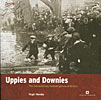 The Extraordinary Football Games of Britain
The Extraordinary Football Games of Britain
by Hugh Hornby
English Heritage, £16.99
Reviewed by John Turnbull
From WSC 255 May 2008
Staring each other down across a rutted meadow in the Scottish Borders as daylight fails, two participants in the 2006 Shrovetide football match in Denholm, Roxburghshire, might be about to re-enact Monty Python’s semaphore-based version of Wuthering Heights. The caption to the photograph on page 131 of Uppies and Downies – the latest publication in the Played in Britain series – explains that this is what the unpredictable cross-country ramble offered at that moment: a game of wits between two men – one Uppie and one Doonie – several hundred yards apart, tramping through field and wood.
The image illustrates several aspects of festival football games, whose heritage might date back 900 years but which have dwindled due to urbanisation and trends toward propriety. First, “football” as a catch-all term might be a misnomer. Author Hugh Hornby prefers to call them mass participation games, or simply Uppies and Downies. (Uppies, generally speaking, constitute town dwellers born or with ancestral roots upstream of the prevailing water feature. Downies, or Doonies in Scots, are the downstream opponents.) Early in the 19th century, Denholm and three other Scottish Border towns with enduring Shrovetide contests switched from a kicking game to handba’, mainly to limit damages.
So the player toting the ba’ in Peter Holme’s photograph has licence to transport it by whatever means necessary – even by car, if he can make arrangements via mobile phone. In this case, Hornby explains, the player squirrelled the palm-sized leather ba’ in a tree. He collected it later to score a completely valid “hail”, or goal, accomplished by touching the ba’ to a designated landmark.
The Denholm situation offers a tactical variant of the reality in many Shrovetide games. Several pictures in this generously illustrated book show steam-emitting scrums, with players grappling on foot or on the floor either for possession or to push the gridlock in the desired direction. At this year’s match in Jedburgh, also in Roxburghshire, a reporter for a Borders newspaper described the action as a “cross between a rugby scrum and the furtive, collaborative milking of a cow”.
Three years of scrum-side viewing and participation at all 15 surviving games – including Cornish hurling in the south-west – have permitted Hornby, former curator of the National Football Museum, to write authoritatively on all the variations in terrain and tactics. With maps, a games calendar and historical perspective on each Shrovetide match, in addition to the school variants at Winchester, Eton and Harrow, Uppies and Downies provides all one needs to enter the fray – minus the ankle-supporting gaffer tape and fluorescent clothing helpful when treading over beck or moor after dark.
Even in ancestral days, the festival matches were not casual kickabouts. Researchers believe informal football games occurred throughout the year, in various forms, although they did not leave an archival deposit. Historians have largely discredited the idea that codified association and rugby football evolved directly from the folk or Shrovetide precursors. Instead, the attendant ribaldry, singing and processions have transferred over time to modern football fandom – a link, writes Hornby, “to a way of life that has now disappeared”.